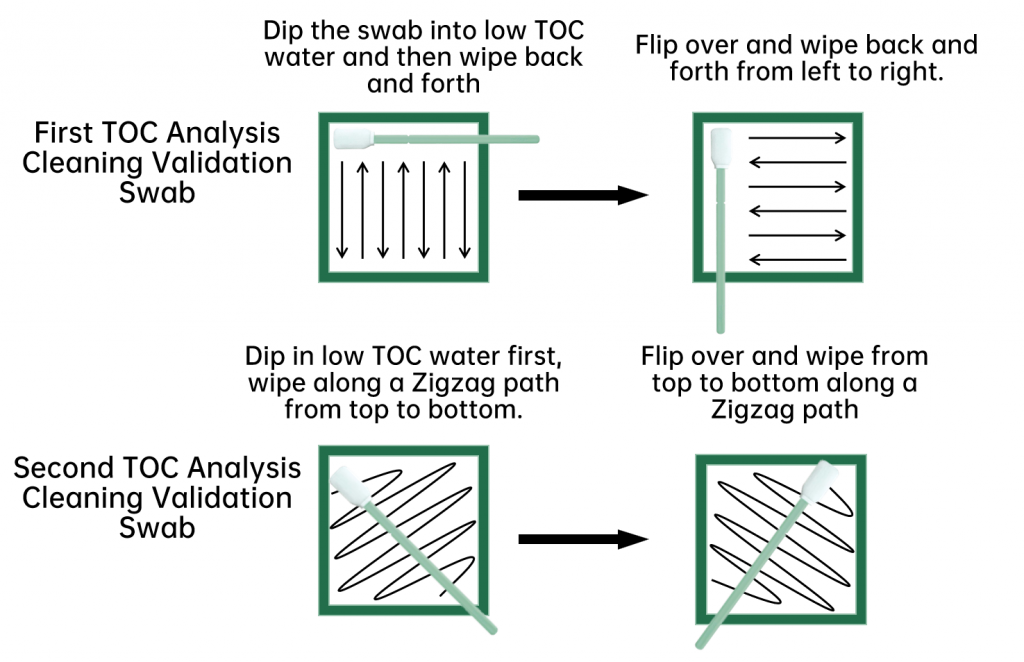Application and Advantages of TOC Cleaning Verification
5288The correspondence of carbon content between carbon dioxide and total organic carbon is used so that the total organic carbon in aqueous solution c...
View detailsSearch the whole station Pandemic Supply
Cleaning validation usually employs two sampling methods: rinse sampling and wipe sampling.
Rinse sampling is typically used to collect samples from large surfaces such as floors or walls. A liquid solution is poured onto the surface and then collected and measured for TOC levels to determine the quantity of organic matter on the surface.
Wipe sampling is typically used to collect samples from smaller surfaces such as equipment or tools. A specialized TOC cleaning validation swab is used to wipe the surface and then placed in a <10 ppb sample bottle for subsequent testing.
When conducting swab sampling, there are two critical steps that must be considered to optimize the sampling material and residue, in addition to the analysis itself:
Step 1: Use a specialized TOC cleaning verification swab to take a sample from the surface in contact with the product.
Step 2: Transfer the residues from the swab to the extraction solution (usually low TOC water)
The material of the sampling swab can affect the sampling efficiency. Conventional cotton swabs used in the past may release particles or fail to release the sample into the extraction solution. Special TOC cleaning validation swabs have good abrasion resistance and are compatible with most solvents, including acetone. They have excellent absorption and locking ability to solvents, and their sampling efficiency is outstanding.

To ensure that the sampling point represents the ‘worst case’ scenario of the equipment, use TOC cleaning validation swabs to repeat the sampling process within a specific rectangular area. After wiping, the extraction solution on the swab should be left as little as possible on the surface. In addition, after the cleaning process involving high temperature drying, the equipment surface needs to be cooled to room temperature before sampling.
After sampling, the sampling recovery rate can be improved by optimizing the extraction method, such as using a vibration table or ultrasonic bath to enhance the release rate of residues/samples in the sampling cotton swabs, which mainly depends on the type and condition of the residues.
“HCY, Health care for you” is our forever mission. We dedicate to offering safe & reliable products and medical services with our global creditable partners. HCY has already supplied to WHO, MAYO clinic, MGI, DDC, Yale University, Qorvo, Quanterix, Thomas Scientific, SD biosensor, Cardinal Health, Cleveland Clinic, Mars Petcare & LumiraDx, etc. in the past years.
The correspondence of carbon content between carbon dioxide and total organic carbon is used so that the total organic carbon in aqueous solution c...
View detailsSwabbing is the preferred method to validate critical cleaning within pharmaceutical manufacturing environments. The 1993 FDA Guide to Inspections states that direct surface sampling (e.g., wi...
View detailsIn industries where strict hygiene and quality control are of utmost importance, such as pharmaceuticals, food and beverage, and electronics, clean...
View detailsTOC sampling verification is a process of evaluating the cleaning effect or whether the environment, samples, etc.
View detailsWe value your privacy We use cookies to enhance your browsing experience, serve personalized ads or content, and analyze our traffic. By clicking "Accept All", you consent to our use of cookies.
Our Privacy Policy